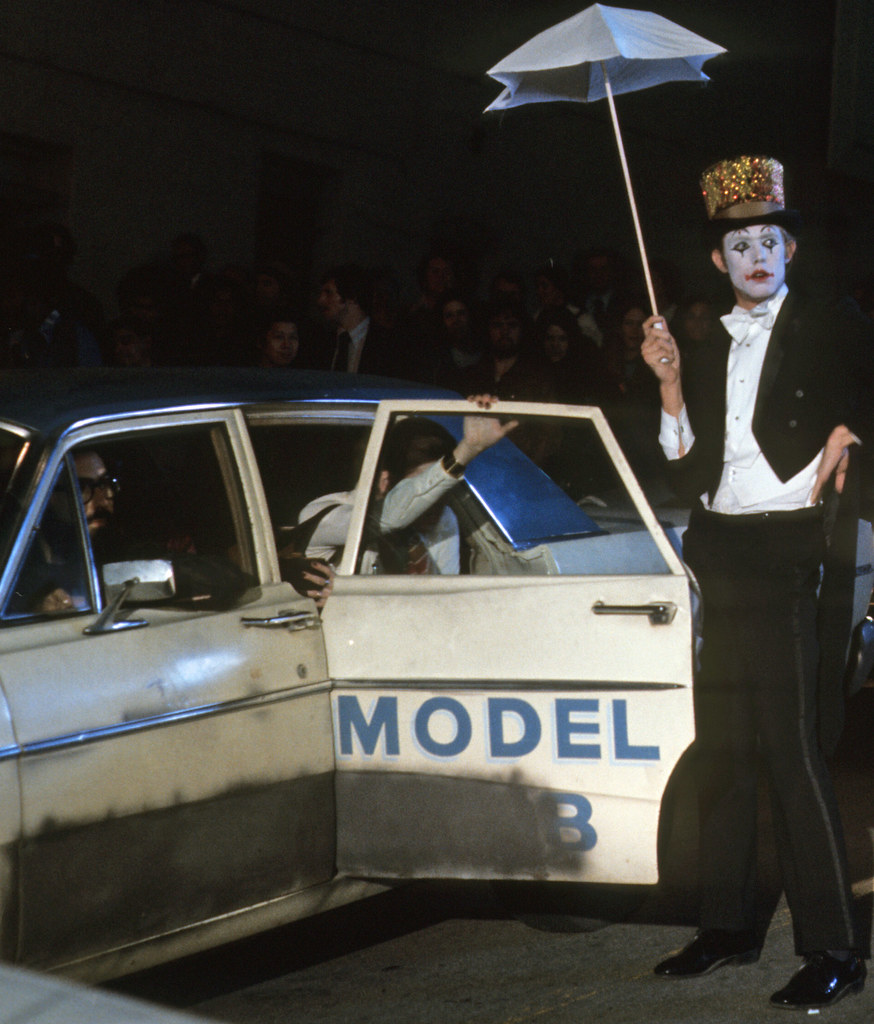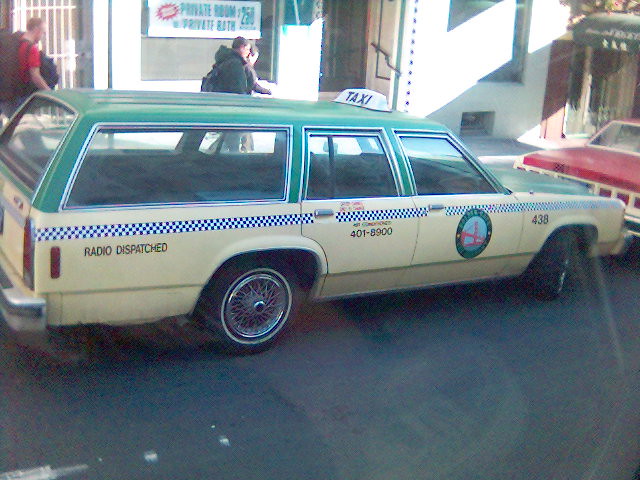
Halloween, North Beach, early 1970s: photo by Mr Flikker, c 1975
I was knocking around San Francisco in the 1970's looking for a way to make a few bucks. A friend, a jazz saxophone player, who drove a taxi suggested getting a hack license. I did and drove cab for two years. At the time there were numerous small cab companies, fly by the seat of the pants operations, hiring anyone without a felony conviction who could steer an automobile. There were also four larger companies that had radio dispatch service -- you could supplement street pickups with home calls. Yellow had most of the radio business, followed by DeSoto and Veterans Cabs, the Grey Ghosts. You'd see them working the higher elevations, Pacific Heights and Nob Hill residences. Their drivers were often older, nicely attired. The fourth, City Cab, where I worked, got the scraps from the table. City Cab radio service covered Tenderloin bars and dives in the Outer Mission too shabby for the other companies. If you needed a cab in Hunter's Point, it was a waste of time to call Yellow, you called City. We had more in common with the independents -- no dress code, lots of writers, artists, stoners and a few miscreants. Many of the cabs were in a state of automotive decay, but all had a radio. You paid the company to rent the cab, your "gate," paid for gas and tipped out the dispatchers and doormen who could reward you with lucrative airport runs. It took the better part of the shift to make expenses. Anything you took in after that was in your pocket. Any time you didn't have a fare you were losing money. Anyone together enough to raise their hand streetside could get into a tiny room with you. You might guess this led to a lot of situations demanding a high degree of resourcefulness, and that guess would be right, but that's not what I want to talk about -- I want to tell you about Jimmy the Glove. Jimmy was the gas man. You'd get your car from him at the start of the shift and return it to him at shift's end. Jimmy was a short guy with greying hair who wore overalls that started clean at the beginning of the shift but acquired multiple layers of oil and grime by the end. And outsize gloves of course. He was often in a rage, directed at management, regarding the sorry state of the cab fleet. It wasn't unusual to find him throwing empty oil cans against the wall intoning exotic and profane fulminations directed at the company. He was always kind to the drivers and I liked him a lot. Once a month Jimmy would show up at the cab barn dressed in a swank suit, vest and tie, unroll a craps layout on top of the pool table and run an all night craps game for which he was both croupier and stickman. City Cab had its own literary magazine, the New Deep City Press. It featured poetry, journalism, short stories and art by drivers with the occasional contribution from locals like Gary Snyder and Spain Rodriguez. A 75 cent cover price and a few ads (Keystone Korner was an advertiser) kept it afloat for several years. Somewhere along the line the idea came up that it'd be a good idea to have a centerfold and the honor went to Jimmy the Glove. He appeared reclining on a sofa, naked but for gloves covering his genitals. It ran next to his "Fading the Main" column on craps strategy and was a hit with everyone. I think the cab barn, a metal shed, is still standing out near Bayshore and Oakdale but City Cab is gone, having splintered into several smaller companies. At that time San Francisco was a city with plenty of room for writers and artists who had day jobs to pay the rent. The "sharing economy" services, Uber and Lyft, and the faceless behemoths of the google bus fleet are a cold bore next to the color of the cab business back then. The New Deep City Press is a window into a bohemian subculture at a very particular time in San Francisco.

@jacobevans #sftaxi: image via Ethan @braunethan, 13 October 2012

Will
Smith made me late for work. Old school San Francisco taxi parked in
the Tenderloin during use as movie prop in the Will Smith film Pursuit
of Happiness.: photo by peko-chan, 26 September 2005


The New Deep City Press, Spring 1977, cover by Jamie Maddox. The New
Deep City Press presented the world as seen by San Francisco
taxicab drivers in the 1970s. The publication nicely captured the spirit
of the times in words, images and original art.: image via World of Taxis

Drivers pose for the camera at City Cab in San Francisco, 1976.: image by The New Deep City Press via World of Taxis

Drivers pose for the camera at City Cab in San Francisco, 1976.: image by The New Deep City Press via World of Taxis
Ooops, disappearing post. Was here, then wasn't, now is, again. Sorry about that.
ReplyDeleteThe first time this went up, yesterday, there was this comment from Tom Raworth:
Thanks to John for the clear reminder. Anything from Dick Gallup on this subject? Regards, Tom
There was also this back channel comment from Aram Saroyan:
I want to hear more—ran into Dick Gallup driving a cab back then.
The mysterious Monsieur Dick alas has not yet checked in but, marvel of marvels, John reports Dick "still drives and dispatches for one of the City Cab splinter companies".
John doesn't drive cab any more. He is a practising musician and teacher of music. Here he is working at a gig in the city a few years ago -- backing Frank Jackson on bass. From 3:40 he shows a bit of his art.
Frank Jackson Quartet: Confessin' the Blues @Castagnola's, SF, 14 January 2010
And while in explainer mode... may as well reveal the driver in the top shot here was a particular friend of John's, Harvey Robb, also a musician.
John writes,
"A note on Model Cab. It was run by Guy and Winston Wong, notoriously cheap and borderline criminal owners whose cabs were all moving heaps of groaning metal. The saxophone player mentioned was Harvey Robb, a superb musician and terrific guy. He drove for Model for a year, quit and moved to Rose Cab. I later shared an apartment in Glen Park with him and stayed in touch over the years, and I'd count him as one of my closest friends. He died of cancer last fall. I loved the man and miss him. Amazingly, that's Harvey behind the wheel of the Model Cab in the photo!"
Thanks Tom, I saw John Clark play once, at a house under the oak trees on the hill above Sausalito -- a friend of mine was living there then, there was a grand piano in the room, she knew John and there he was, playing the stand up bass with someone on the piano -- such a gentleman, what a pleasure . . .
ReplyDeleteGreat to read/see this. There was an independent fiction film about SF cab drivers. I think it was called Seventh Signal but I probably got that wrong. Alan Senauke also drove cab, but in NYC.
ReplyDeleteNice post, Tom. My best friend was a minicab driver in the east end of London back in the 80s and the informality, jokeiness (blokeiness?) and friendship amongst the crew always struck me as a world in itself.
ReplyDeleteWonder if you've seen the film, Night on Earth?
Best,
b.
Many thanks for coming along for the ride, gents. Taxis and music -- small worlds within worlds.
ReplyDeleteI believe John and Alan Senauke played together for a while, back in the day.
Ah to be young or anyway at least a wee bit younger and hear music on a pleasant day under oak trees on the hill above Sausalito!
And, yes -- Night on Earth...
Would love to see more of the Deep City Press. It sounds incredible. Those places where work is community are much harder to find now.
ReplyDeleteThanks, Dunc.
ReplyDeleteFor sure, "Where work is a community" is a place not easy to discover in the White World any more.
Scans of some of the publications of The New Deep City Press can be seen at this site, which also represents a good range of other historical cabbie sites (several UK sites, mostly London naturally, though there way well be a bit of Brum hid away in here too):
World of Taxis -- Culture and History: Deep City Press